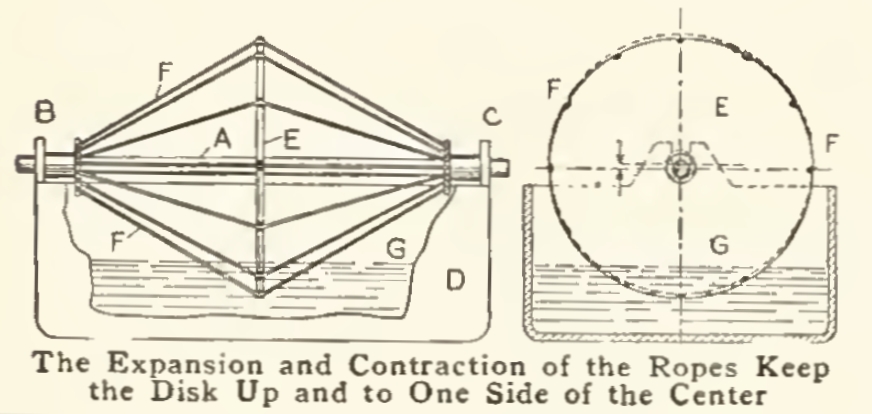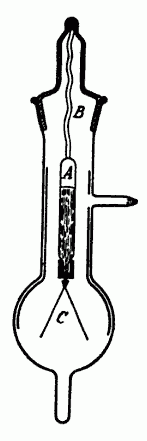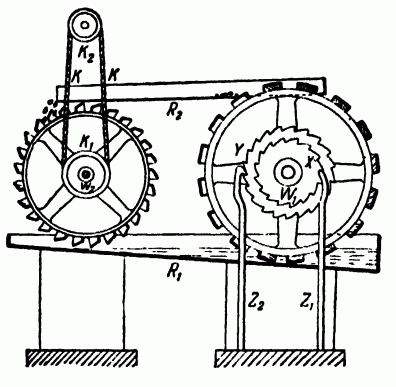Fake perpetual motion machines
you can build.
Methods for achieving the appearance of perpetual motion have been published in many places. I've brought some of them together here to show that it isn't hard to deceive those who want to believe in perpetual motion. This can help educate people to skeptically look for evidences of such deception.
Revolving Shaft Without Power.
This device description is from the book The boy mechanic : book 2: 1000 things for boys to do. (c1915). Handicraft Publisher: Chicago : Popular Mechanics Press. Also available in a reprint edition.
The device illustrated seems paradoxical for it apparently works without any power being applied to it, making from two to three revolutions per hour, which, though slow, is nevertheless motion, requiring energy.I haven't built one of these yet. But if any of you boy mechanics reading this have built one, I'd like to hear about your results. You need ropes that shrink when wet. But wet ropes are heavier than dry ones, so you need to balance things carefully. The source suggests 12 or more ropes. Not too many more, for if there are too many, the wetting of only a few of them won't shift the disk's center of gravity much.
The shaft A is supported on the edges, in the bearings B and C, of a tank, D. A disk, E, having a central hole larger in diameter than the shaft, is located at the middle of the latter. The disk is supported by 12 or more cotton ropes, F. The tank is filled to the level G with water. The lower ropes, being immersed in the water, shrink and lift the disk slightly above the center in the position of an eccentric, as shown by the dotted lines in the sketch. The center of gravity of the disk in this position, being higher and slightly to one side of the shaft, the disk has a tendency to turn around. The motion drives the next rope into the water where it becomes soaked and shrinkage takes place again, lifting the disk to a higher position, while the rope coming out of the water dries out. The ropes emerging from the water but not yet thoroughly dry cause the upper part of the disk to be in an eccentric position laterally with reference to the center of the shaft, thus causing the center of gravity to be not only above but also slightly to one side. - Contributed by Charles Roberts, Brooklyn, N. Y.
Rubber Band Heat Engine.
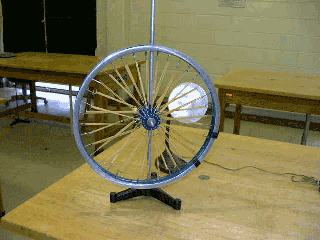 |
| Rubber band heat engine. |
|---|
A simpler device is sometimes seen in physics deartment display cases, to perplex undergraduates. A lightweight metal wheel rim has many spokes, made of rubber bands, attached to a low friction hub. In a vertical orientation the wheel turns slowly. But there's a trick hiding in plain sight. An incandescent lamp illuminates the wheel from one side. The heat from it makes the rubber bands on that side slightly warmer, so they contract in length. Yes, rubber acts that way and you can find out why here. This shifts the wheel rim off-center making the wheel continually heavier on one side. Of course, if that light is turned off at night, the wheel stops turning.
See Haverford physics demos. from which the picture was taken. In the picture the lamp is too obviously part of the system (and its source of energy). The deception works best if the whole thing is in a glass display case and the lamp is positioned to appear as if its purpose was only to let you see the wheel in better light.
Classic Fakery Methods.
All of the ideas in this section are fake perpetual motion. They are not intended to demonstrate over-unity performance. They simply run for a long time without diminution of speed, and do no useful work. They work because they are low friction and low mass and do not require much power to sustain their motion.
Perpetual motion clocks.
Clever clockmakers have long been building novelty clocks that mimic well-known perpetual motion machine designs. Their purpose is to make the clock appear to be powered by a perpetual motion mechanism clearly in view. But the real power that keeps the mechanism going is hidden, usually a standard wound spring or a lifted weight with its winding mechansim cleverly hidden.One of these recently surfaced on YouTube, claiming to be perpetual motion. It is just a reproduction of the "Ignatz" or "The Flying Pendulum Clock" invented and patented (286,531) in 1883 by Adler Christian Clausen and J. C. Slafter. See Flying Pendulum Clock. It has a "tetherball" escapement prominently mounted on top, providing visual interest. You can see a description and picture of it at Pieces-n-time.com. Though the patent describes it as an "improved" clock regulator, it actually regulates a clock very poorly. But it is fun to watch.
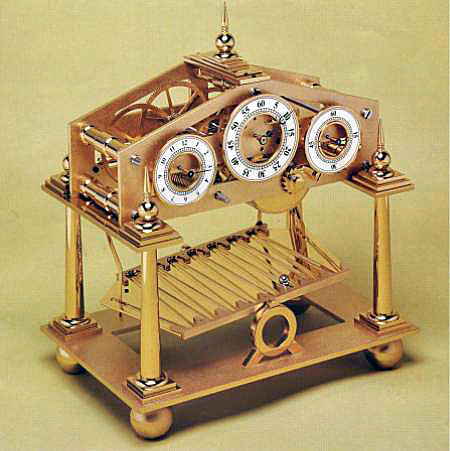 |
| Model of the Congreve Clock ModelWorks International Ltd. |
|---|
Sir William Congreve designed a clock regulated by a metal ball rolling on a zig-zag track on a large tilted flat plate. When it completed its route, the plate was triggered to tilt in the other direction and the action repeated. This was patented, and even today hobbyist modelmakers like to build replicas of this clock. The driving spring was concealed within a drum attached to a large gear. So some people thought that the ball was driving the clock. But it was only regulating the clock. Regulating it rather poorly, actually. You may recall that Congreve is the person responsible for that chain of sponges perpetual motion machine idea.
Other methods are used by clock and watchmakers to make mechanisms that "never need winding". These include wristwatches whose springs are wound by the motion of the wrist, clocks powered by changes in atmospheric pressure, and those powered by ambient temperature changes.
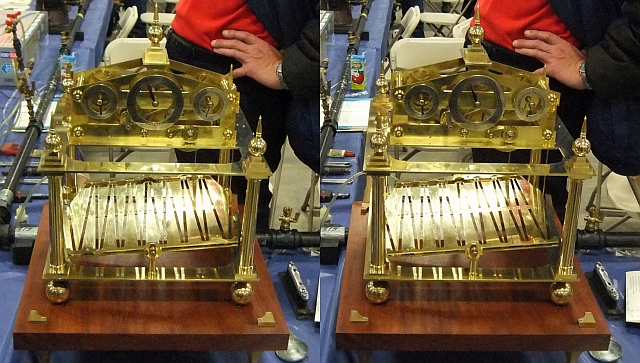 |
| Modern Replica of the Congreve Clock Stereo for cross-viewing. |
|---|
Radium Perpetual Motion
|
Physicist R. J. Strutt (1842-1919) built a radium electroscope in 1903. It continued its motion for an incredibly long time. An evacuated quartz glass bulb contained an inner glass capsule with a small amount of radioactive radium. The electron emission from the radium (A) charged the gold-leaf leaves (C) which slowly moved apart until they touched the metal foil on the inside of the chamber and discharged. Then the charging and discharging cycle started over again. This process was limited by the decay life of the radium isotopes, which means that the charging gradually decreased over time. A very long time. The half-life of the isotope Radium-226 is 1601 years. Then the charging rate would be only half what it was initially, but the action would still continue.
Hidden Batteries.
One of the simplest deceptions is to hide batteries in the device itself. A simple wheel, even a large one, with high quality dry bearings, requires very little power to sustain its motion. Imagine, for example, a bicycle wheel. Now consider how many batteries could be hidden inside the rubber tire. Quite a few; enough to power the wheel for several years. Of course you'd want to use batteries with a long shelf life. Museum displays of such machines are usually in place for at least a year. Some years ago mercury batteries would have been the best choice, but today lithium batteries would be preferable. A small electric motor could be hidden within the wheel's hub, and its electrical power conducted through the wheel's spokes, one of them subtly insulated at each end. Just an idea you might want to try.Another "in plain sight" method is to put batteries inside a metal cylindrical shell that plays the role of a moving weight. People don't expect batteries to be hiding in moving parts. Batteries can be obtained in flat sheet form, like those used in instant photographic film packs that power the camera's flash. The hiding places are limited only by your ingenuity.
|
Atmospheric Clocks
In 1774 astronomer and mechanic James Ferguson saw and described the barometric clock shown here. It had a large mercury barometer with 150 kg of mercury in two glass vessels, one with its mouth in the other. Linkages and an ingenious mechanism at the top responded to changes in mercury level, turning a wheel and ratchet that wound the spring that maintained the clock's motion. Similar, but smaller, clocks driven by atmospheric pressure changes are still made today.
Thermal Clocks
The same sort of ratchet wheel winding scheme can also be driven by thermal expansion and contraction of metal rods. Yakov Perelman in his 1913 book Physics as Entertainment describes such a clock using the thermal expansion and contraction of liquid glycerin. The clock was tested and ran for a year without attention. Glycerin remains liquid from 30°C to 290°C so it is ideal even for outdoor clocks. Only a 2°C fluctuation of temperature is enough to sustain the clock's operation.
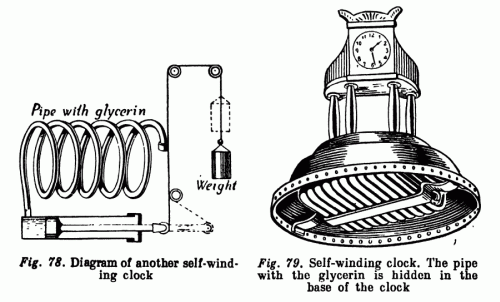 |
|
This thermal powered device is described in Perelman's book (Fig. 77, p. 113). It has a ratchet mechanism powered by thermal contraction of metal rods Z1 and Z2 as they cool. The ratchet Y turns as Z2 contracts and ratchet X turns as Z1 contracts. This slowly turns the wheel W1 at the right which is a "bucket" wheel that lifts mercury from the reservoir R1 at the bottom to the reservoir R2 at the top. From there the mercury drips onto the wheel W2 at the left, turning it, and also the pulley K1 driving belt K that runs up to drive pulley K2 and then something else unspecified. The mercury seems unnecessary when a simple spring would do. This looks very much as if it were designed primarily for visual interest and deception.
Solar Power
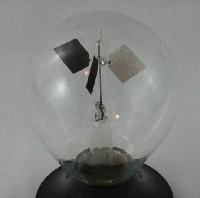 |
| The Crookes Radiometer. |
|---|
The Crookes Radiometer (sometimes called a "Light Mill") was invented in 1873 by Sir. William Crookes, and is still available from science toy stores. It consists of an evacutated glass bulb with vanes inside balanced on a needle point. The vanes (usually four) are blackened on one side, silvered on the other. In sunlight they turn rapidly and continually. Even with a 100 watt incandescent bulb a few feet away they turn slowly.
Some textbooks used to explain this by saying that the light photons were absorbed by the black side, but reflected from the silvered side, and therefore they gave greater momentum to the vane when striking the silvered side. That sounds good, but the actual device turns in the "wrong" direction.
These toys do not have a perfect vacuum. There's residual air inside, and the molecules hitting the vanes gives the vanes greater momentum than that of photons simply rebounding from the silvered surfaces. The Crookes radiometer is therefore a heat engine.
When light falls on the black vanes it is absorbed and the temperature of the black side rises. Light falling on the shiny side reflects and imparts very little energy to the shiny side of the vane. Therefore the black side has higher temperature than the shiny side, and the glass bulb is cooler that either of them. The black and shiny sides must be thermally insulated from each other to maintain the temperature difference, but the black and white paint itself can provide sufficient insulation.
So when molecules strike the black vanes and rebound, they gain energy from the vane and rebound with increased speed. When they strike the shiny side (which is cooler) they gain less energy from the vane, and gain less speed. The momentum change of the molecules bouncing from the black side is greater than when they bounce from the shiny side, and therefore the vane rotates with the shiny side of the vanes in the forward direction. The molecules are slowed when they strike the cooler glass bulb. This molecular dynamics has greater effect on the vanes than the photon momentum mechanism. The experiment has been done in near perfect vacuum, and then the photon momentum model is confirmed. But the radiometer toys you can buy have imperfect vacuua and are dominated by molecular kinematics.
Use of solar cells might seem an obvious choice for a perpetual motion deception. But it's hard to disguise these cells, and the game would be given away by simply covering the whole machine with a black cloth, or turning out the room lights. This is not a very practical method for deceptive purposes. Better to power your fake PMM with something less easily detected—something invisible.
Electromagnetic radiation.
We are surrounded by electromagnetic radiation from radio and television stations. A museum display device can be sized to act as an antenna for local radiation of this type, converting it to DC power to drive the device. The conversision mechanism can be easily hidden in the machine parts themselves. The downside is that during massive power outages in a city, the local broadcast stations may go off the air and your machine would slow to a stop. So a backup power source would still be needed if the machine were in a public setting, like a museum. Why not set up your own broadcasting station in a nearby room, with battery backup power? Some skeptic might come along with an electromagnetic radiation detector and expose the deception. And the Federal Communications Commission might go after you for illegal broadcasting. Best to use a naturally existing environmental power source.
Moving air.
In any room there are convection air currents, but these are hardly reliable enough in strength and direction for deception in a public setting where people move about the room. Museum PMM deceptions are usually housed in a glass or clear plastic case elevated on four slender legs to convince people there's nothing connected to the machine inside. It also keeps people's hands from touching the moving parts. Those legs must be sturdy enouough to keep the case from vibrating and must be obviously solid, not hollow. But how can the viewers tell whether the legs are hollow? Even thin rods can be hollow. If the supporting legs were made of clear glass or lucite they could still be hollow and no one could tell. They would make fine pipes to convey moving air into the cabinet from a compressed air source under the floor. I can imagine two such hollow pipes forcing air into the cabinet and two on the other side acting to pull air from it, setting up a strong air circulation in the cabinet, invisible to onlookers. A model windmill inside could be driven by the air, and in turn driving a large wheel, while onlookers might think the wheel was driving the windmill. Downside: Moving air usually makes noise.Just a crazy idea, you say? Well a hidden source of compressed air was one of the methods of deception used by John Worrell Keely to keep his perpetual motion scams going during the 30 years he successfully duped investors in his Keely Motor Company.
Electromagnetic boost.
 |
| Top Secret spinner toy. |
|---|
Roger Wayne Andrews obtained in 1974 Patent #3783550 for a "Novelty Electric Motor". This patent covered a variety of toys that sustained motion for days with no apparent source of energy. They all had hidden batteries (usualy 9 volt) connected to a transistor and a tapped electromagnet coil. The first one marketed was called Top Mystery manufactured by the Andrews Mfg. Company and sold by the Johnson Smith Company (of Whoopie Cushion fame). It consisted of a simple plastic base on which a small top (22) was set spinning on a concave surface. The top enclosed a hidden permanent magnet and an electromagnet was hidden in its base. As spinning tops will, it wandered around the slightly concave surface, but when it got near the center (lowest point) its magnet was close enough to the electromagnet's coil (16) to induce a current in it, and a portion of this tapped coil supplied a potential to the base of a transister (20), large enough to trigger the transistor into its "on" state, allowing the battery (18) to send current through the entire coil. Its magnetic field gave the spinning magnet a slight boost, hardly noticable. The transistor acts as an electronic switch. To further misdirect observers, a small bump (12') in the concave surface causes the spinner to be deflected toward the outer rim of the device. The resulting spinner path could be quite complex and seemingly unpredictable.
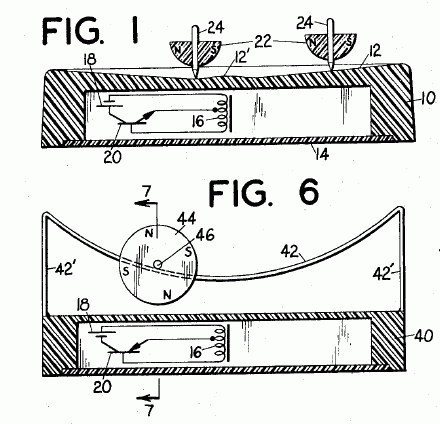 |
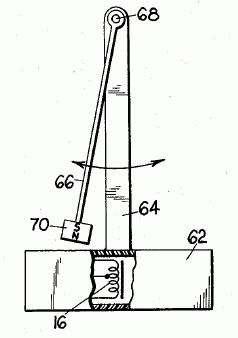 |
| Various forms of the Andrews toys. | |
|---|---|
A fresh 9 volt battery would sustain continuous operation for up to seven days. For occasional use the battery would last more than six months (or its shelf life).
 |
| Underside of Andrews spinner. The transistor is at the bottom of the coil. Cross-view stereo. |
|---|
This toy is still marketed today under the name Top Secret and costs about $10. Many variations using this same "secret" power source are seen in toy and novelty stores, made in Japan or China. The transistor-coil assembly could be removed and adapted to other deceptive uses, and I suspect that it, or something much like it, is the motive power behind some claimed perpetual motion machines seen on U-tube.
None of these toys need an on/off switch. When the moving magnet is removed, the transistor is in its "off" state, and no power is drawn from the battery. Generally the coil, transistor and battery are hidden under a felt pad on the bottom of the base, which can be pried up to put in a fresh battery. When used occasionally, the battery lasts nearly as long as its shelf life.
Another version had a spinner on concave rails. The principle was the same. Another obvious application described in the patent had the same triggered coil under a pendulum. This is reminiscent of other devices experimenters used to build even before transistors were invented. They had a couple of mechanical magnetic reed switches to turn the electromagnet on and off, all hidden, along with the battery, under the table or in the base of the pendulum.
I'm sure you can think of ways this basic principle could be applied to many other fake perpetual motion designs.
Human-powered fakery.
The Hammel spinner and related devices are all over the internet these days [2012]. Those that work have the common feature of a magnet held in the hand near a spinning disk or wheel that has permanent magnets. Videos show the wheel turning, supposedly forever, or until you get tired of holding the magnet.Where does the energy come from? From the hand holding the magnet, through the idemotor effect. See Why Won't My Perpetual Motion Machine Work? Always be suspicious of any claimed PMM device that only works when someone holds a magnet near it.
One of the first devices of this sort was Howard Johnson's magnetic motor, which was patented in 1979.
Other videos on the web show similar devices but with the outlying magnet fastened in place, or mechanically linked to the motion of the wheel. These are faked.
 |
| Paper spinner trick. |
|---|
Another demonstration of this sort is an old party trick. A lightweight tissue paper is lightly folded and balanced on the point of a pin. When a person's hand is brought near, the paper can start rotating, due to the convection air currents near the warm hand.
Power in plain sight.
Here's a clever device described by Yakov Perelman in his Physics for Entertanment.
I think the cleverest "perpetual motion" machine ever invented was one displayed at the Paris Exposition in the 1860's It consisted of a large wheel with balls rolling about in its compartments. The inventor claimed that nobody would ever be able to stop the wheel. Many visitors tried to stop it but it went on turning as soon as they took their hands off it. Not a single person realized that the wheel turned precisely because of the effort he made to stop it. The backward push he gave to stop it wound up the spring of an artfully concealed mechanism.Of course the wheel needed a hidden source of power to get it going, probably that spring was wound in advance of the demonstration. Here's an exercise for the reader. One of the classic cases in the history of fake perpetual motion devices is that of Johann Bessler (a.k.a. Orffyreus) who demonstrated (in the early 1700s) a large wheel that could lift weights, run a wood saw and do other kinds of work. Later versions of this wheel had the property of operating in either direction, and if given a small push in either direction would gain speed then settle in to a constant speed determined by two large pendula attached to it (which likely acted as speed governors). One impressive feature was that the wheel could lift someone off the ground if he tried to bring the wheel to a stop. See Johann Bessler.
The story is full of clues to how such deceptions could be accomplished. Could these two wheels have something in common? I think it possible, and am surprised that this trick has not been used more recently for demonstration purposes. Get the power (or at least part of it) from the very processes that seem to be showing that the wheel is producing power. This is functionally like the energy recovery braking system in hybrid automobiles, using the power that would otherwise be wasted in conventional friction braking to charge the batteries instead.
Here's an exercise for readers. Build a device that gets its sustaining power from attempts to try to stop it from turning. It needn't be as large as these two were. (The largest Bessler wheels were 12 feet in diameter.)
Electromagnetic Induction.
 |
| Feedback. The simplest free energy device. |
|---|
The figure illustrates an old joke making fun of perpetual motion ideas that feed back the output of a device to power the input. Even the most naive perpetual motionist recognizes the absurdity of this idea, and wouldn't even be tempted to try it.
But what if we could, by deception, turn this joke into a fake device that would seem to produce energy from nothing? It has been done. See: Free Energy Generator (Original) and Free Energy Generator 2.
So how was this trick done? Unless the inventor reveals his method, we can't be certain, but just from the videos we can use our knowledge of electricity to devise a way to duplicate the effect. Once you "get it" you really appreciate the cleverness of the inventor who made this device, and his skill in deception when making this video. I'm reminded of a talented stage magician executing a flawless illusion. And he knew his physics, too.
I was tempted to explain how to do it in this document. In fact I even had the text written. But on second thought, I resisted. I've seen how many people on the internet pretend to understand physics, but are deceiving themselves. One of them might "try this at home" and mess it up, with possibly catastrophic consequences, and I might feel some responsibility. Now I know that similar electrical tricks have been used safely for over a century in physics lecture demonstrations. But in this modern society, with hungry lawyers prowling for prey, one has to be careful. I've long felt that fools deserve the consequences of their foolishness. Like mountain climbers, folks who walk on hot coals, walk across Niagara Falls on a tightrope, or people who want to circumnavigate the world solo in a rowboat. All of these can be done, but they carry significanat risk. Also, they can have serious consequences for others.
Some of the ways that electrical tricks of this sort can be done require homebuilt devices that plug into the household electrical system, and these devices are not approved by the Underwriter's Laboratory. They would violate the electrical codes of most communities. A house fire could result from faulty construction of the device, and if the cause were discovered, fire insurance would probably not cover it. There is nothing so foolproof that some fool can't mess it up.
More examples.
For more examples of deliberate perpetual motion machine deceptions see Unworkable Devices as Fine Art.There seems to be a thriving cottage industry of hobbyists making fake perpetual motion devices and posting videos on the internet. Some very nicely made faked models of clasic perpetual motion device proposals can be found here: Perpetual Motion Machines (Hypothetical). There's a disclaimer, "Not to trick, but to inspire" at the upper left of the first title screen.
Send comments, corrections and additional ideas to the address shown at the right.
Return to top.
Return to the Museum's main gallery.
Return to Donald Simanek's front page.
